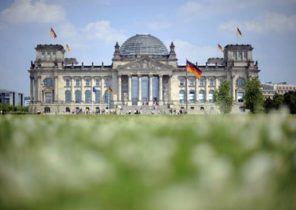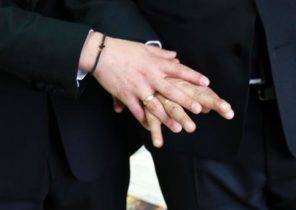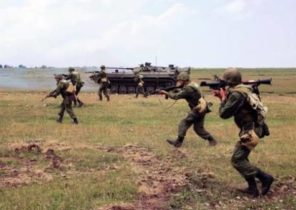
In Finland in the beginning of 1917, on the eve of the February revolution, the mood was dominated by, in no way heralding the imminent change.
In Europe, meanwhile, for the fourth year continued the war takes the lives of millions of people. For example, Russia mobilized to participate in the war of 16-18 million people, but not from Finland.
The Grand Duchy of Finland, unlike other parts of the Russian Empire, remained aloof from the battles. The reason for this was the distrust of the Finns from Russia and the tenacity of the Finns themselves. The fact that the Finnish people have for many years provided strong resistance to the policy of Russification pursued by the tsarist government in Finland.
The first period of infringement of the rights of the Finns came in the first years of the new century, a new attack on the rights of the Finns Imperial administration went after the outbreak of the First world war, in late 1914.
Finns and Russians are completely different understand the Autonomous status of Finland. The Finns believed that it is a constitutional struggle for the rights of the nation, while Russia believed that it is about unity and defense of the state.
From the Grand Duchy of Finland had its own army, but it was destroyed in the early 20th century, in the first period of Russification. Russia feared that the Finnish army at a critical moment might prove disloyal to the Empire, and it was decided its dissolution.
Recruits went on strike — instead of service in the Russian army, the Finns had paid “military millions”
Emperor Nicholas II in the summer of 1901 issued a Manifesto on military duty, in accordance with which the Finns were obliged to participate in the defense of the borders of the Empire. On the basis of this Manifesto was disbanded almost all units of the Finnish army, and all her possessions were donated to Russia.
Instead of a private army of Finns wanted to send to serve in the Russian army. In accordance with the new law, the first recruitment drive was held in 1902. The Senate approved the initiative of the king, however, the Finns massively opposed it. The organizer of the resistance was a group of young activists, who in 1901 had established a body of passive resistance, called Kagaali, Kagan. Originally, this term in Hebrew Kahal, קָהָל (“the Assembly of the people, the gathering”) was used by the Russian conservative press to ridicule the activities of the Finnish anti-Russian activists.
At first, the Kahal distributed leaflets, spoke publicly against conscription and was engaged in ideological activities, but later moved to forms of active resistance, in particular, from obtaining weapons and carried out the shooting.
In 1902, in Finland at the initiative of Elites held a series of acts of civil disobedience, which in Finnish is called kutsuntalakko (“recruitment strike”). About 65 priests, the Finnish Evangelical Lutheran Church had refused to read the decree on conscription in the Church, and about half of the Finnish municipalities the population is actively opposed conscription.
In April 1902, the resistance resulted in riots, particularly in Helsinki. The protesters gathered on the Senate square near the building of the police station. They expressed their protest against the policy of Russian authorities with whistles and insults of the police. After the mounted police failed to bring the situation under control, Rulandske the Governor, General M. Kaigorodov gave the Cossacks the order to disperse the rally. On the Senate square were sent to 100 Cossacks, the appearance of which most people dispersed. However, despite the fact that in the square there are only a few, Kaigorodov still gave the Cossacks the order to oust the people power. The result is a large number of people, including women and children, suffered. The actions of the Cossacks caused anger among those who watched, Finns and Cossacks pelted with stones, and who have used and machetes.
The Governor reported that in the evening on the square of the expected arrival of a large number of people after the end of the work shift, and the situation threatened to spiral out of control. As a result, the Governor was smart enough to withdraw from the square the Cossacks, and the situation calmed down.
The result of disobedience was the fact that conscription for Finns to enter the steel, but the Finns had to pay to the state Treasury for compensation, the so-called “military millions” in the amount of 20 million marks. Sharply it was opposed by, in particular, the Finnish labor movement.
However, Finnish historians believe that these millions saved the lives of tens of thousands of Finnish men, who in the end had to go to the front of the First world.
This fate has not escaped other ethnic minorities living in the Russian Empire. For example, the territory of today’s Estonia to the war have been sent about 100 thousand people.
It should be remembered that the Russian army still fought and Finns. We are talking about approximately a thousand volunteers, and Finnish officers serving at that time in the Imperial army. The most famous of them — at that time still unknown, General C. G. E. Mannerheim, who later became Marshal and President of Finland. At the beginning of 1917 the 12th cavalry division fought in the mountains of the Eastern Carpathians, on the territory of Romania. At the end of January 1917 the division was transferred to the reserve in Bessarabia, Chisinau (Chisinau).
Cossacks beyond the Arctic circle admired among Finnish women
Due to the lack of Finns own army, the country was sent to tens of thousands of Russian soldiers. Russian from the very beginning of the war feared a landing from the sea of German troops and further advance on Petrograd, in 1917, these fears intensified. In Finland was not less than 50 thousand Russian soldiers of the land forces, and major naval base of the Russian Baltic fleet.
Also to the North of Finland, Rovaniemi, above the Arctic circle, was sent hundreds of Russian soldiers from different parts of the Russian Empire.
“Rovaniemi was like a big bubbling pot international with a variety of people. Local residents have lost in this human sea, it was impossible to distinguish among a large number of military in the city. Cossacks-the lancers rode their beautiful horses, the Kyrgyz are on their little ponies, Caucasian, handsome with excellent posture, she stood admiring gaze out of Windows.” (From the notes of a resident of Oulu Aino Toivonen)
The Chinese built fortifications in Finland
During the First world war, Finland conducted a large-scale construction of military fortifications. The local population meant the possibility of employment and good earnings, but the construction work has generated and phenomena, which caused concern among the local population.
At first the emphasis was on the construction of fortifications in Helsinki and in other places on the South coast, but further trenches and fortifications were also built in inland regions of Finland.
The construction work has had a very positive effect on the employment situation and the economy in General. In the beginning of 1917 in the construction of fortifications worked about 30 thousand people.
In search of work in Helsinki and went to France Kuusela from Loimaa:
“In Helsinki I just found a job at the shipyard in Sveaborg. The work consisted in the digging and clearing the soil from the stones. I also built fortifications in different parts of Helsinki, in Oulunkyla, Kauniainen, Pitajanmaki. Salary — 50 pennies per hour.” (From the memoirs Kuusela, audio-recording in the Working files)
For the construction of fortifications were paid for the time not bad, at least for the Finns.
“At the construction site were very different people. In addition to Russian, the Chinese. Finnish workers came from all over the country. The Chinese was quite a lot, and they could often be found on the streets of Helsinki. They had the custom of decorating yourself with ribbons, which they took at the city cemetery. Tapes were common funeral texts.” (From the memoirs of France Kuusela)
The Chinese have caused surprise and even fear among the local residents. All this was fueled by various rumors. Professor Aspelin Eliel-Haapkyla wrote in his diary:
“Their presence here is the greatest danger to society. Women and children dare not go out after dark”.
“Pay the Chinese for 60 pennies a day. In food they are good cats, rats, frogs and earthworms. They are cold, they are very badly dressed. They always ask: “Will winter never end?!””.
Besides Chinese in Finland worked and lived thousands of other foreigners, mainly Russian. At the same time about 20 thousand Finns lived or worked in the capital of the Russian Empire Petrograd.
By the beginning of 1917, Finland began to be felt shortage of food
The beginning of the third year of the war was marked by residents of Finnish cities, growing food shortages. Finland was totally dependent on supplies of grain from abroad, and world war led to the cessation of imports from many countries, including from Germany. When supplies from Russia encountered difficulties, the situation began to deteriorate rapidly in the Finnish cities.
Food shortages have led to conflict between urban and rural populations. In the cities experienced food shortages and angry at the villagers, who, in the opinion of many, fatten, and in the villages the peasants did not understand why they need to give their products for a pittance, but to the townspeople received grain at a cheap price.
Despite the fact that Finland was a cattle country, in the stores it was difficult to find milk and butter, as these products have gone on the black market and for export to Petrograd, where they were paid more.
Meat, in turn, rapidly disappeared from the shelves, since around half of the meat were confiscated for the needs of the Russian army.
The biggest threat to the food supply of the population represented, however, the fact that Finland is almost entirely dependent on imports of grain. Nearly all the grain needed for bread baking were supplied from Russia. The Finnish authorities estimate that Finland have 170 cars of grain, flour and sugar from Russia every day!
The authorities tried to bring the situation under control by imposing different restrictive measures, in particular regulation of prices and rationing of food. By early 1917, the major cities have introduced a card system of food distribution. On cards dispensed sugar, butter, milk and meat.
Well as money depreciated rapidly. Inflation was the result of imbalance in the economy. On the one hand, the military economy was going through its Golden years. Belligerents Russian Empire wanted guns, crafts, underwear, socks, and Finnish industry has received a huge number of orders.
Of money in circulation was spinning a lot, but in a situation when the country did not have enough food and materials, they quickly and rapidly depreciated. The first to revolt was the factory workers who began to demand higher wages. For example, in Turku the workers of wood processing plants required to raise salaries by at least 100% in the beginning of 1917.
Strikes covered and the capital of the Russian Empire Petrograd: at the end of February old style (early March — according to the new) in the Finnish Newspapers wrote about the strike at the Putilov plant, the largest artillery plant of the country, where he worked for 36 thousand people. Also in the Finnish Newspapers wrote about the bread riots in the Russian capital.
About the imminent advent of independence, dreamed of a small group of activists
Anxious mood began to reach out to the people of Finland, but, despite this, in early 1917, few could anticipate what events will soon turn to all the inhabitants of the Russian Empire. Moreover, the imminent onset of the independence of Finland at that time dreamed of only a few.
Specifically, such thoughts are harbored only the activists operated underground, including in the ranks of the movement of Rangers.
Jaeger movement emerged in the early 20th century as a response to the policy of Russification. According to activists, a social position gave them the right to answer violence with violence.
The movement of hunters were attracted to its ranks especially students. The first group of volunteers secretly went to Germany to receive military training at the beginning of 1915, and at the end of the same year in Finland began a secret recruitment across the country.
In the spring of 1916 of the group of Finnish volunteers formed the Prussian Royal Rangers battalion No. 27, led by major Maximilian Bayer.
Russian authorities learned about the actions of the Rangers in the fall of 1915, and in Finland, the arrests began. Many detainees were taken to Petrograd to the House of detention, known as “Shpalerka”, and to the freedom they came only after the February revolution.
In early 1917, the Finnish jaegers were on the Riga front. The battalion was transferred to Mitava (now Jelgava) that the territory of present Latvia, and the Finns were ordered to form ski units, with the aim of penetrating the enemy’s rear. The Finns, however, considered that the risk associated with this operation are too large, and dozens of Finns refused to comply with the order. One revolt of the Finnish jaegers were shot in front of his section, and dozens were sent to a construction battalion in Germany.
Meanwhile, in Finland, people lived normal, everyday concerns: how and where to get food, what to do with rapidly devaluing money, how to survive until next summer with an empty cellar, and the lack of firewood.
From the capital of the Empire increasingly came rebel rumble, concern was growing among Finland in the Russian military. The historic events of late February a few days left.
Sources: Article by Yle journalist Esko Vargo “Tammikuu 1917: Uppiniskainen kansa” (22.1.2017); Wikipedia







